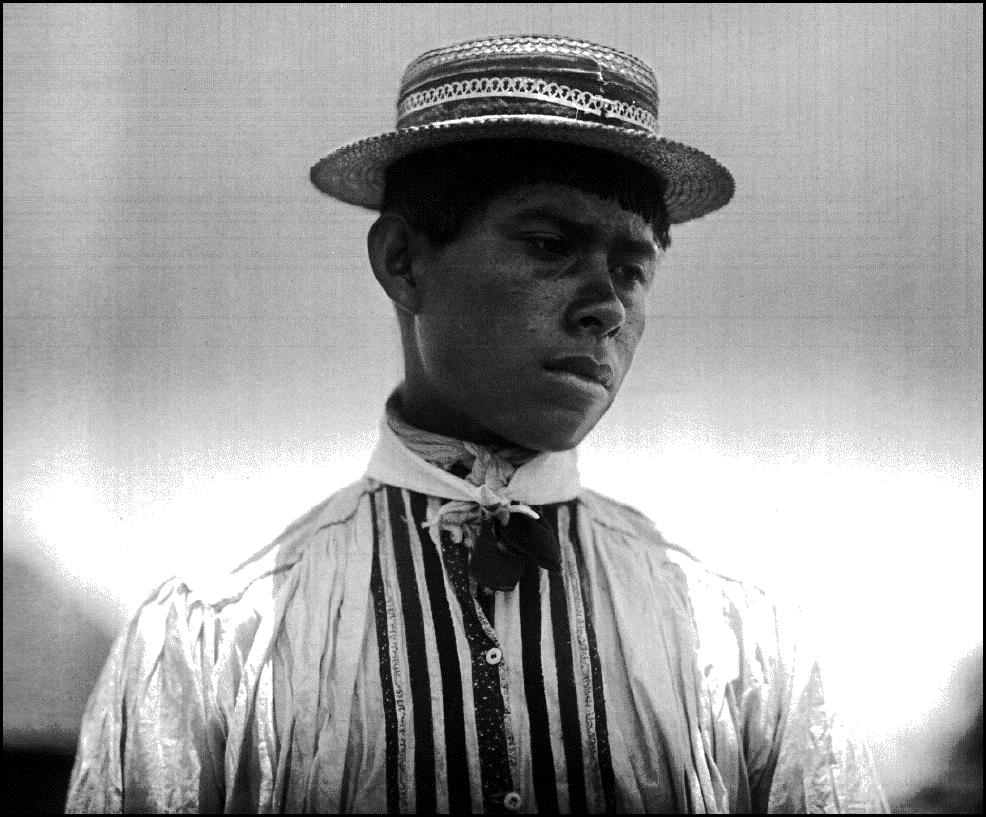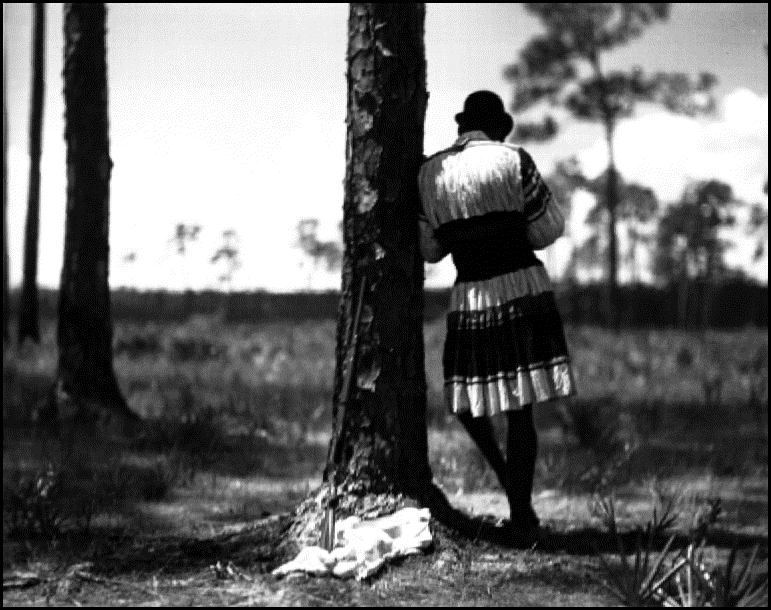
Hidden Seminoles
Julian Dimock's
Historic Florida Photographs
Jerald T. Milanich
Nina J. Root
(University Press of Florida)

Like all American Indians, the Seminoles of Florida had it bad once the foreigners came to town. The colonialists gave them three important presents: Christianity, a depth and variety of social diseases, and, ultimately, The Removal.The first taught them guilt; the second taught them that their conquerors had no shame (VD wiped out 95% of the Indian population) --- and the third, mostly delivered under the aegis of Andrew Jackson, either killed them outright or forced them to resume their lives in the wastes of Oklahoma.
Jackson's three Seminole Wars --- 1818 - 1858 --- brought their population down from over 3,500 to an estimated 200. The few survivors disappeared into the swamps of south Florida, where they made a living fishing and hunting and hiding from what one of them referred to as the twin scourges: "government agents and meddling missionaries."
In 1905, Anthony Weston Dimock and his son Julian arrived in the Everglades looking for the few Seminoles still living there. Over the previous forty years, Anthony had made and lost several fortunes on Wall Street, but he bailed out just in time to miss the great Panic of 1907. He then wisely decided to become an investigator of natural curiosities of America. He and Julian met with the Seminoles from 1905 - 1910, making at least four expeditions to interview and photograph them. (The two of them went on to become noted naturalists, publishing books and mountains of articles in the Washington Post, Harpers, the Illustrated London News, and Country Life in America.)
On each of these trips, Julian took photographs which they submitted for publication along with their articles. They ultimately ended up with 1,900 glass plate negatives.
Over a hundred of these photographs are included in this volume, showing the Seminoles in their native dress, with representations of medicine men, games, canoes, housing, hunting, moonshining operations and family life.
The photographs are reproduced here full page, and are beautifully done. Some --- often of the young Seminole men --- are close-ups, and show a degree of introspection that elevates them to photographic art.
§ § § For some odd reason, the editors have chosen to focus their attention on the Dimocks and not on the Seminoles. And it is odd, for the elder Dimock comes across as nothing more than a stock broker type (have you ever tried to talk anthropology with your stock broker?) One gets the feeling that Dimock Sr. used the exotic Seminoles and their exotic ways and dress merely as a come-on for his "nature" stories.And their native dress is glorious if not fulsome. Thus comes the question, not answered here: Why would those who chose to live in the astonishingly humid swamps of Florida want to wear clothing that was so all-encumbering. Why would a people living in 110° days with 110 percent humidity --- a constant enervating mugginess (have you ever been to Miami in late July?) --- why would they be wearing such elegant dresses for the women (full length sleeves, elaborately banded bodice, dozens of necklaces (made from Busycon shell), full-length skirts with gorgeous calico design; and for the men, elegant skirts with buckskin leggings, long-sleeved blouses with high, decorative collars (and even dark ties). Their head-dress would be a credit to Yves St. Laurent.
Had they been dolled up for Dimock's camera or --- as appears from the shots of them fishing and hunting and paddling about in such garb --- were these their everyday work clothes? No answers are given in Hidden Seminoles.
There may be a logic to such outfits in such a place. Those of us who live in the tropics also live with a merry band of blood-suckers. We wear long-sleeved shirts, long pants and socks to avoid their beastly sucking. Otherwise we are doomed to scratch the night away, what with all the stabbings that the chiggers, red bugs, mosquitoes and horse-flies leave behind (and they are stabbing: these suckers do just that: they stab you and suck you).For the Seminoles in the early twentieth century to appear without full-length clothing would be dangerous, for not only would they be exposing themselves to yellow fever, dengue swamp fever and malaria, they would be inviting sunstroke. But we have to ask: where did the inspiration for the highly artful, classical decoration on and about that clothing come from. We would hope that if the editors plan additional works on the Seminoles, they might explain this intricate art of those who magically survived America's own ethnic-cleansing programs from so long ago.
I grew up in northern Florida. Up there, we were vaguely aware of the Seminoles, but it was not until much later that we became aware of Andrew Jackson's personal vendetta against them. Once I wrote to the editors of the sole Jacksonville daily, the Florida Times-Union, suggesting that they undertake a campaign to rid us of the blight of living under the moniker of that scrofulous old poltroon.
The city had once been called "Cow Ford" since it overlooked a part of the St. Johns River that was a suitable passage for the many bovines who made up the original cultural elite of that august city.
I suggested to the Times-Union that we rechristen ourselves "Cow Ford" to honor our original and humble if not colorful beginnings, and to rid ourselves of living under the opprobrium of that notoriously vulgar buffoon. The Times-Union, a snooty publication if there ever was one, never noted for having a sense of humor, high-hatted my very funny suggestion.

--- L. W. Milam